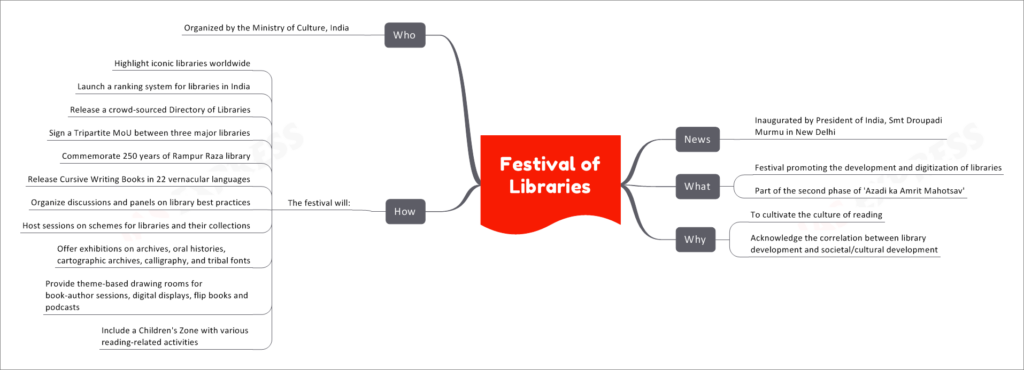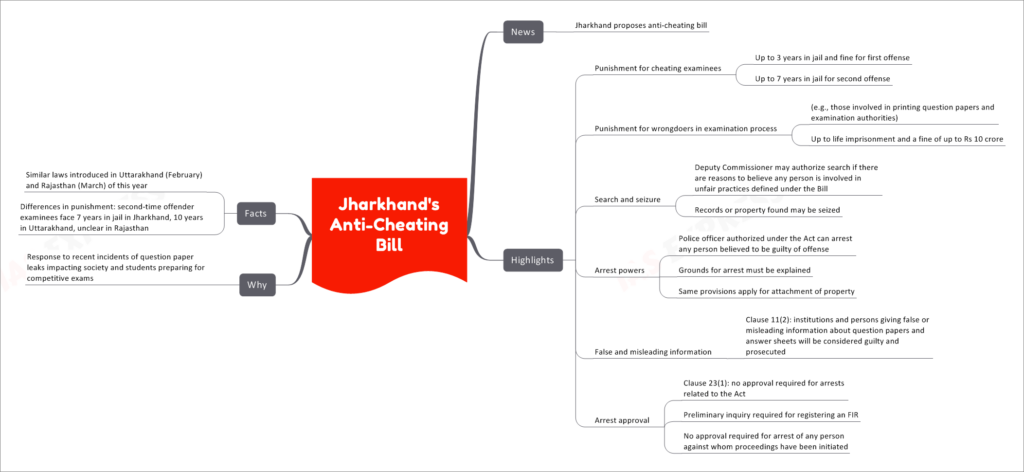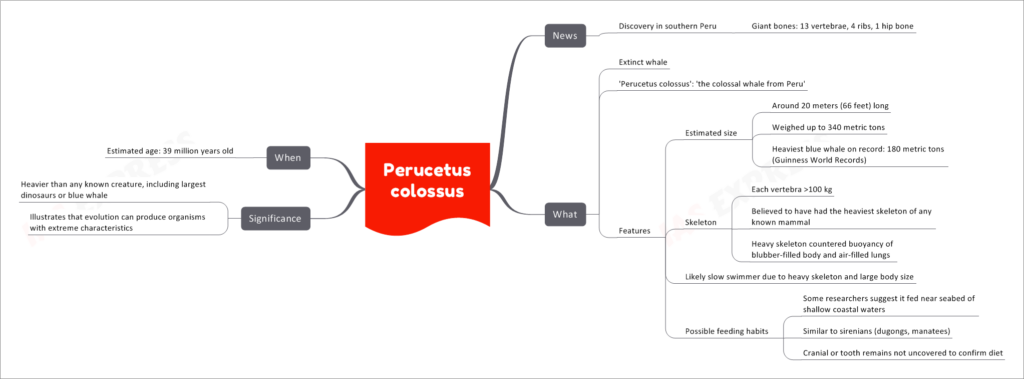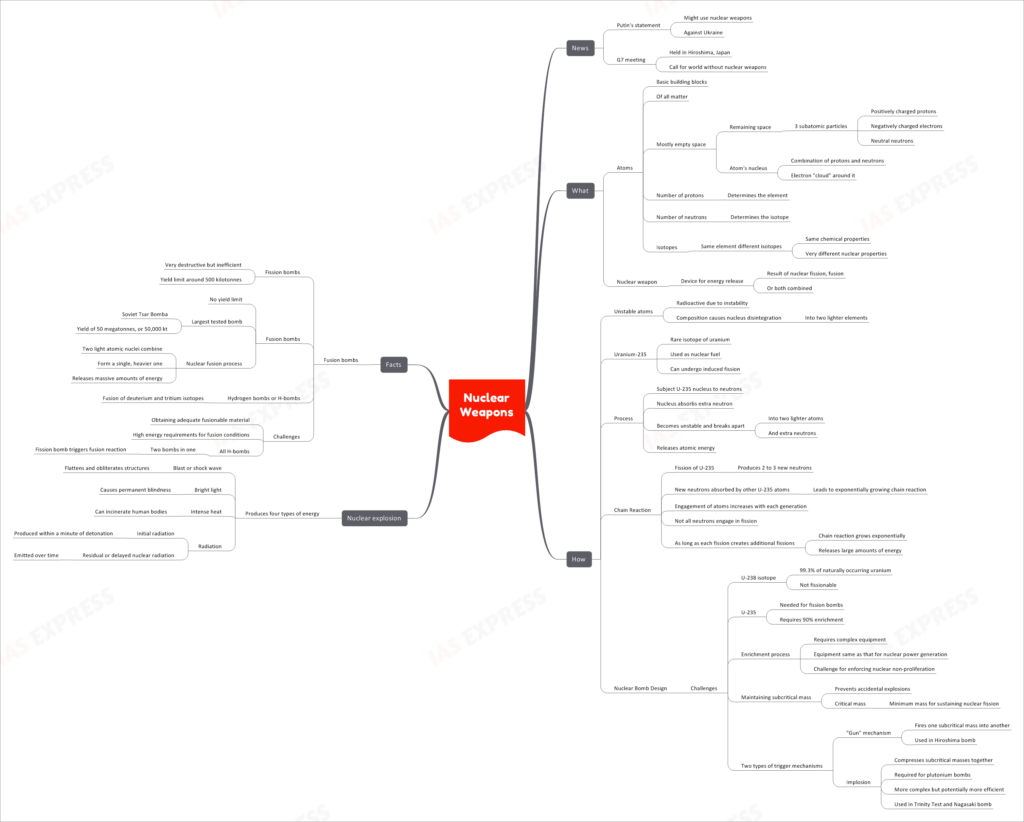[Newsbit] 05.08.2023

Festival of Libraries
The Festival of Libraries, a grand celebration promoting the development and digitization of libraries, was recently inaugurated by the President of India, Smt Droupadi Murmu, in New Delhi. This festival is a significant part of the second phase of 'Azadi ka Amrit Mahotsav,' a national commemoration of India's 75th year of Independence. Let's delve into the purpose, events, and participants of this enriching festival.
Purpose of the Festival
The Festival of Libraries aims to cultivate a culture of reading and acknowledge the critical correlation between the development of libraries and societal and cultural progress. By promoting the digitization and modernization of libraries, the festival endeavors to make knowledge and information more accessible to all.
How the Festival Unfolds
The Festival of Libraries encompasses a wide array of events and initiatives:
- Highlighting Iconic Libraries: The festival brings attention to renowned libraries worldwide, celebrating their contributions to knowledge and culture.
- Ranking System for Indian Libraries: A new ranking system for libraries in India will be launched to assess and recognize the excellence of these institutions.
- Crowd-sourced Directory of Libraries: A comprehensive directory of libraries, sourced through crowd participation, will be released to provide a collective repository of information.
- Tripartite MoU Signing: Three major libraries will sign a Tripartite Memorandum of Understanding to strengthen collaboration and knowledge-sharing.
- Commemorating Rampur Raza Library: The festival pays tribute to the Rampur Raza Library, marking its 250th anniversary, acknowledging its rich heritage.
- Promoting Vernacular Languages: Cursive Writing Books in 22 vernacular languages will be released to preserve and promote linguistic diversity.
- Discussions and Panels: The festival will host insightful discussions and panels on best practices for library management and operation.
- Library Schemes and Collections: Sessions will be conducted to enlighten attendees about schemes related to libraries and their collections.
- Exhibitions: Engaging exhibitions on archives, oral histories, cartographic archives, calligraphy, and tribal fonts will showcase diverse cultural treasures.
- Theme-based Drawing Rooms: Visitors can attend book-author sessions, digital displays, flip books, and podcasts in creatively designed drawing rooms.
- Children's Zone: A dedicated zone for children will offer various reading-related activities to encourage a love for books from an early age.
The Organizers
The Festival of Libraries is organized by the Ministry of Culture, India, in collaboration with various stakeholders from the literary and cultural sectors.
Jharkhand’s Anti-Cheating Bill
In response to recent incidents of question paper leaks affecting students preparing for competitive exams, Jharkhand has proposed an anti-cheating bill. The bill aims to curb unfair practices in examinations and hold wrongdoers accountable.
Highlights of the Anti-Cheating Bill
The proposed anti-cheating bill in Jharkhand includes the following key provisions:
Punishment for Cheating Examinees
- First Offense: Cheating examinees could face up to 3 years in jail and a fine.
- Second Offense: For repeat offenders, the punishment may be increased to up to 7 years in jail.
Punishment for Wrongdoers in the Examination Process
- Those involved in printing question papers and examination authorities may face severe consequences, including up to life imprisonment and a fine of up to Rs 10 crore.
Search and Seizure
- The Deputy Commissioner may authorize a search if there are reasons to believe that any person is involved in unfair practices defined under the bill. Records or property found during the search may be seized.
Arrest Powers
- Police officers authorized under the Act can arrest any person believed to be guilty of an offense. The grounds for arrest must be explained, and the same provisions apply for property attachment.
False and Misleading Information
- Institutions and individuals providing false or misleading information about question papers and answer sheets may be considered guilty and prosecuted under the bill.
Arrest Approval
- No approval is required for arrests related to the Act. A preliminary inquiry is required for registering an FIR, and no approval is needed for the arrest of any person against whom proceedings have been initiated.
The Motive Behind the Bill
The proposal for the anti-cheating bill comes as a response to recent incidents of question paper leaks, which have had a significant impact on society and students preparing for competitive exams. The bill aims to address the rising concerns of unfair practices in examinations and restore faith in the integrity of the examination process.
Facts and Comparisons
- Similar laws have been introduced in Uttarakhand in February and Rajasthan in March of the same year.
- There are differences in punishment for second-time offender examinees in these states. While Jharkhand imposes up to 7 years in jail, Uttarakhand has a punishment of up to 10 years, and the penalty in Rajasthan remains unclear.
Perucetus colossus
A remarkable discovery in southern Peru has unveiled the fossil remains of an extinct whale named Perucetus colossus, aptly known as "the colossal whale from Peru." This ancient creature's features, size, and significance shed light on the extremes of evolution and the fascinating world of prehistoric marine life.
The Discovery
In the southern region of Peru, paleontologists made a groundbreaking discovery of the remains of Perucetus colossus. The findings include 13 vertebrae, 4 ribs, and 1 hip bone, providing valuable insights into the ancient creature's anatomy.
What is Perucetus colossus?
Perucetus colossus is an extinct whale species that lived around 39 million years ago. Its name, "the colossal whale from Peru," reflects its massive size and its location of discovery.
Features of Perucetus colossus
Impressive Size and Weight
Perucetus colossus is estimated to have been around 20 meters (66 feet) long, making it one of the largest known creatures in history. It is believed to have weighed up to 340 metric tons, surpassing the heaviest blue whale on record (180 metric tons, Guinness World Records).
Heaviest Known Skeleton
The skeletal remains of Perucetus colossus offer another astonishing characteristic. Each vertebra of this ancient whale weighed over 100 kilograms, contributing to its title as the mammal with the heaviest known skeleton. This heavy skeleton likely counteracted the buoyancy of its blubber-filled body and air-filled lungs.
Slow Swimmer
Given its massive size and heavy skeleton, Perucetus colossus was likely a slow swimmer compared to modern whales. The weight of its skeleton may have hindered its agility in the water.
Possible Feeding Habits
While researchers have not uncovered cranial or tooth remains to confirm its diet, some speculate that Perucetus colossus may have fed near the seabed of shallow coastal waters, similar to sirenians such as dugongs and manatees.
Significance of Perucetus colossus
Perucetus colossus holds significant importance in the field of paleontology. Not only was it heavier than any known creature, including the largest dinosaurs and modern blue whales, but its existence also illustrates the remarkable capabilities of evolution in producing organisms with extreme characteristics.
Estimated Age
Perucetus colossus roamed the seas approximately 39 million years ago, offering valuable glimpses into the marine life of prehistoric times.
DRACO
Exciting developments are underway in space exploration as DRAPA (Demonstration Rocket for Agile Cislunar Operations) announces Lockheed Martin's selection to design, build, and test the propulsion system for a Mars mission. BWX Technologies is also involved in building a nuclear fission reactor for the engine. With NASA planning to test a nuclear rocket in space within three years, DRACO is set to revolutionize space travel and offer numerous potential benefits.
What is DRACO?
DRACO, or Demonstration Rocket for Agile Cislunar Operations, is a groundbreaking $499 million program aimed at advancing space exploration and propulsion technology.
The Pros of DRACO
DRACO holds the promise of several potential benefits, including:
- Faster Travel to Mars: The new propulsion system could cut travel time to Mars by 50%, significantly reducing mission duration.
- Greater Fuel Efficiency: The nuclear-thermal engine offers improved fuel efficiency, resulting in reduced exposure of astronauts to the harsh deep space environment.
- Versatile Applications: Apart from Mars missions, DRACO's technology could be utilized for rapid maneuvers of military satellites in Earth's orbit, enhancing space-based operations.
How DRACO Works
The DRACO engine design involves a nuclear reactor heating hydrogen for thrust. The key safety measure is that the reactor will not be activated until the spacecraft is in space. The program will culminate with a flight test of the nuclear-thermal engine, likely orbiting at an altitude between 435 and 1,240 miles. This altitude allows radioactive elements in the reactor fuel to decay to safe levels, ensuring the safety of both astronauts and the environment.
Historical Context
DRACO is not the first attempt to explore nuclear propulsion for space travel. In the 1950s and 1960s, Project Orion aimed to use atomic bomb explosions for spacecraft acceleration. Project Rover and Project NERVA were also earlier efforts to develop nuclear-thermal engines.
DRACO Vs NERVA
A significant difference between DRACO and its predecessors lies in the use of nuclear fuel. While Project NERVA used weapons-grade uranium, DRACO will use a less-enriched form of uranium, making it a safer and more controlled option.
Scheduled Launch
The exciting development is set to take off with a scheduled launch late in 2025 or early in 2026, marking a crucial step in the future of space exploration.
Toshakhana case
In a significant turn of events, former Pakistani Prime Minister Imran Khan has been arrested after being declared guilty in the Toshakhana case.
Toshakhana Controversy
The Toshakhana controversy emerged in August 2022 when the PML-N led government filed a case against Imran Khan. The allegations were related to the non-disclosure of information about gifts received at the Toshakhana and the proceeds from the "illegal" sale of these gifts.
Toshakhana: A Brief Overview
Established in 1974, the Toshakhana is a department under the Cabinet Division in Pakistan. Its primary function is to store gifts and expensive items received by public officials. The rules mandate that officials report all gifts received, and these reports are to be submitted to the Cabinet Division.
Imran Khan's Resistance
After coming to power in 2018, Imran Khan resisted disclosing the details of the gifts he had received. He cited concerns about potential impacts on international relations as the reason behind his resistance. However, he admitted to selling at least four gifts after writing a letter to the Election Commission of Pakistan (ECP). He claimed to have bought these gifts by paying a percentage of their value and included various luxury items.
Court's Findings and Sentencing
The court found Imran Khan guilty of submitting fake details to the Election Commission of Pakistan (ECP) and engaging in corrupt practices related to the Toshakhana case. He has been sentenced under Section 174 of Pakistan's Election Act, which carries a maximum punishment of three years in prison and a fine of 100,000 Pakistani rupees.
Significance of the Conviction
Imran Khan's conviction in the Toshakhana case holds significant implications for his political career. The conviction puts an end to his chances of participating in the upcoming national elections, scheduled for November. This could have far-reaching consequences for the political landscape in Pakistan.
Nuclear Weapons
Recent news highlights the growing concerns about nuclear weapons, particularly in the context of geopolitical tensions. Putin's statement about using nuclear weapons against Ukraine and the G7 meeting in Hiroshima, Japan, calling for a world without nuclear weapons, have brought the issue to the forefront.
What are Atoms?
Atoms are the fundamental building blocks of all matter, consisting of mostly empty space. They contain three subatomic particles: positively charged protons, negatively charged electrons, and neutral neutrons. The atom's nucleus is a combination of protons and neutrons, with an electron "cloud" surrounding it. The number of protons determines the element, while the number of neutrons determines the isotope.
Understanding Nuclear Weapons
Nuclear weapons are devices designed to release tremendous amounts of energy through nuclear fission, fusion, or a combination of both.
How Unstable Atoms Lead to Nuclear Fission
Unstable atoms, often referred to as radioactive isotopes, undergo a process called nuclear fission. During fission, the nucleus of an unstable atom disintegrates into two lighter elements, along with the release of extra neutrons. Uranium-235 (U-235) is a rare isotope of uranium used as nuclear fuel because it can undergo induced fission.
The Process of Nuclear Fission
In a nuclear bomb, U-235 nuclei are subjected to neutrons. When a nucleus absorbs an extra neutron, it becomes unstable and breaks apart into two lighter atoms and releases additional neutrons. This process results in the release of atomic energy.
Chain Reaction: Amplifying the Power
The fission of U-235 produces 2 to 3 new neutrons, which are absorbed by other U-235 atoms, leading to an exponentially growing chain reaction. As more atoms engage in fission with each generation, the chain reaction releases large amounts of energy.
Design Challenges for Nuclear Bombs
Creating a nuclear bomb is a complex task, with several challenges to overcome:
- Enrichment Process: The isotope U-238, comprising 99.3% of naturally occurring uranium, is not fissionable. To build fission bombs, U-235 requires 90% enrichment, which demands sophisticated equipment similar to that used for nuclear power generation.
- Maintaining Subcritical Mass: Preventing accidental explosions involves keeping the mass of nuclear material below the critical mass, the minimum mass required for sustaining nuclear fission.
- Trigger Mechanisms: Nuclear bombs use two types of trigger mechanisms: the "gun" mechanism, where one subcritical mass is fired into another (used in Hiroshima bomb), and implosion, which compresses subcritical masses together (required for plutonium bombs).
The Nuclear Explosion
A nuclear explosion releases four types of energy:
- Blast or Shock Wave: Flattens and obliterates structures in the vicinity of the explosion.
- Bright Light: Can cause permanent blindness for those exposed to it.
- Intense Heat: Can incinerate human bodies and objects nearby.
- Radiation: Initial radiation is produced within a minute of detonation, while residual or delayed nuclear radiation is emitted over time, posing long-term health hazards.
Facts about Nuclear Bombs
Fusion Bombs vs. Fission Bombs
- Fission Bombs: Although very destructive, they are inefficient, with a yield limit around 500 kilotonnes.
- Fusion Bombs: Also known as hydrogen bombs or H-bombs, have no yield limit. The largest tested bomb was the Soviet Tsar Bomba, with a yield of 50 megatonnes, or 50,000 kilotonnes.
Nuclear Fusion Process
In fusion bombs, two light atomic nuclei combine to form a single, heavier one, releasing massive amounts of energy in the process.
Challenges with Fusion Bombs
Creating fusion bombs poses several challenges, including obtaining adequate fusionable material and the high energy requirements to achieve fusion conditions. All H-bombs have two bombs in one, where a fission bomb triggers the fusion reaction.
If you like this post, please share your feedback in the comments section below so that we will upload more posts like this.






